Key takeaways:
- Rehabilitation of cats involves both physical healing and emotional support, emphasizing the importance of patience and trust-building.
- Recognizing signs of abuse, such as fearful behavior and changes in litter box habits, is crucial for understanding a cat’s past and tailoring rehabilitation efforts.
- Effective rehabilitation techniques include positive reinforcement, creating a safe environment, and respecting a cat’s boundaries to build trust and security.
- Personal success stories highlight the transformative power of patience, love, and understanding in aiding the recovery of traumatized cats.
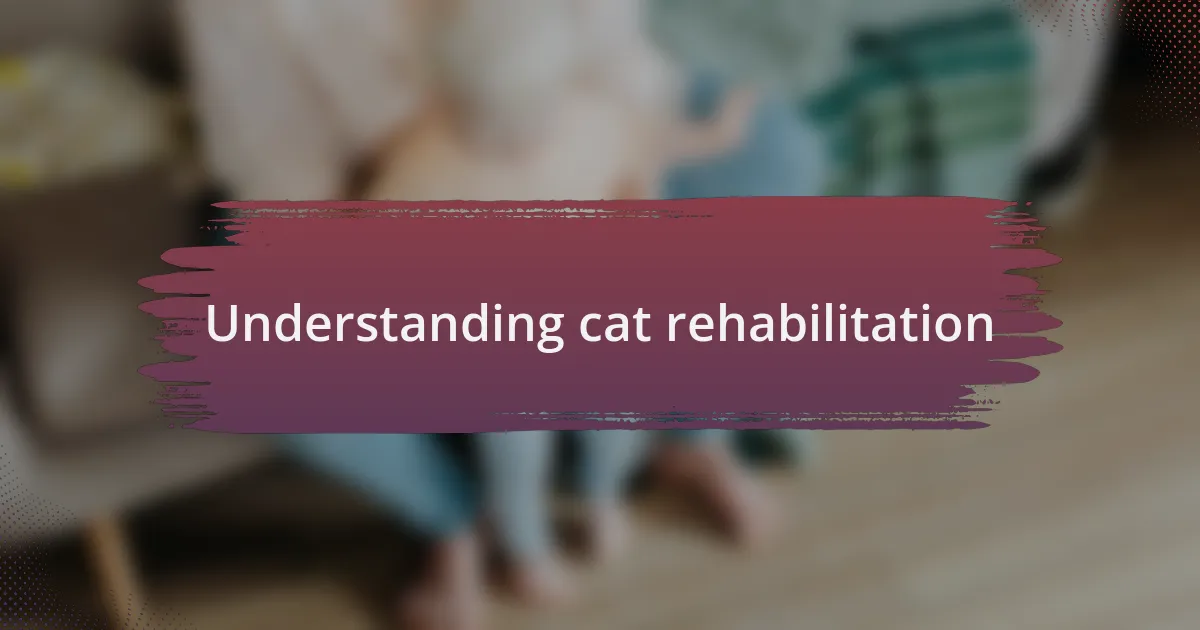
Understanding cat rehabilitation
Understanding cat rehabilitation requires a deep dive into both the physical and emotional aspects of a cat’s recovery. Some may wonder how a traumatized cat can ever trust humans again. I’ve seen firsthand how patience is key; in one case, a once-shy tabby slowly emerged from her shell when offered consistent kindness, transforming from a fearful creature into a curious companion over time.
It’s essential to recognize that rehabilitation isn’t merely about physical healing; it’s equally about rebuilding trust. I remember when I worked with a cat that had been abandoned. It took weeks of sitting quietly in the same room, allowing him to approach me on his own terms, before he would even consider a gentle scratch behind the ears. This experience reaffirmed that fostering emotional security is just as crucial as addressing a cat’s immediate physical needs.
Moreover, every cat’s journey is unique, reflecting individual experiences and personalities. Have you ever considered how a cat’s past might influence its behavior? In my experience, understanding a cat’s background—be it trauma from abuse or neglect—can provide vital insights into their rehabilitation process. Tailoring approaches to each cat’s specific needs not only builds trust but also creates a safe space for healing.
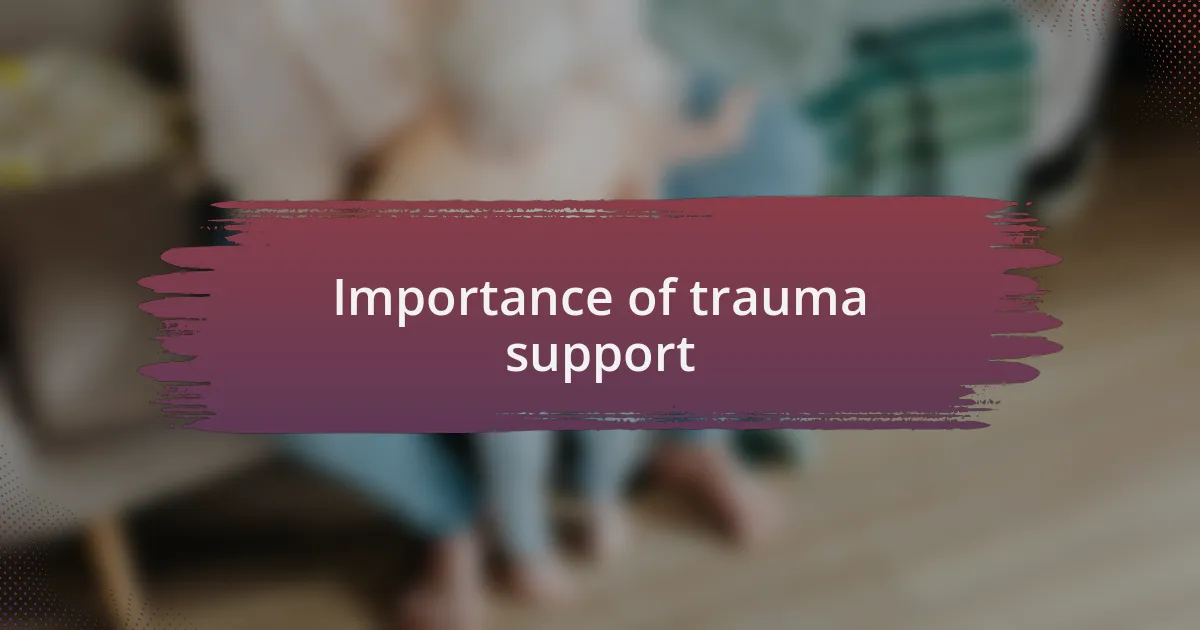
Importance of trauma support
Trauma support is vital for helping cats recover not just physically, but emotionally as well. I recall working with a particularly skittish cat named Luna, who had been mistreated in her previous home. It was astonishing to witness how the gentle support of a dedicated caregiver not only enhanced her physical recovery but also allowed her to show interest in the world around her again. Without trauma support, those small steps towards healing could easily slip away.
Many might underestimate the impact of emotional reassurance during rehabilitation. I remember an instance with a little rescue who flinched at every sound, driven by fear. Sitting with her, speaking softly, and offering comforting treats gradually reassured her that she was safe. It’s a reminder that emotional support can often be the foundation upon which physical healing is built. How can we expect them to flourish without that nurturing environment?
Ultimately, the importance of trauma support can’t be overstated. It’s the bridge that connects a cat’s painful past with a hopeful future. I’ve seen time and again how a supportive atmosphere elevates their well-being, allowing them to thrive in their new lives. Isn’t it incredible that such a strong bond can develop through understanding and compassion?

Signs of abuse in cats
One of the first signs of abuse in cats can be their behavior around people. For instance, I once fostered a cat named Max who would hide at the slightest sound. His persistent fear of hands reaching out toward him resonated deeply with me; it was clear he had experienced something traumatic. Seeing a cat flinch at a gentle touch struck me as a profound reminder of the scars that can remain long after physical harm has ceased.
Physical signs of abuse are equally telling. I remember discovering that some cats have scars or missing fur that hint at past cruelty. I’ve encountered a cat with a matted coat and untreated wounds, and it was heartbreaking. These visible signs tell a story that can often go unnoticed, yet they speak volumes about the cat’s previous environment. How many innocent lives carry these silent testimonies of pain?
Additionally, a change in litter box habits can indicate distress or past neglect, which I find often gets overlooked. In one case, I worked with a cat who stopped using her litter box altogether; it took time, patience, and an understanding of her history to help her regain trust. It’s a stark reminder that behavior is often a reflection of their emotional state. What does it take for these animals to express their pain? Often, it is us offering the patience and understanding they so desperately need.
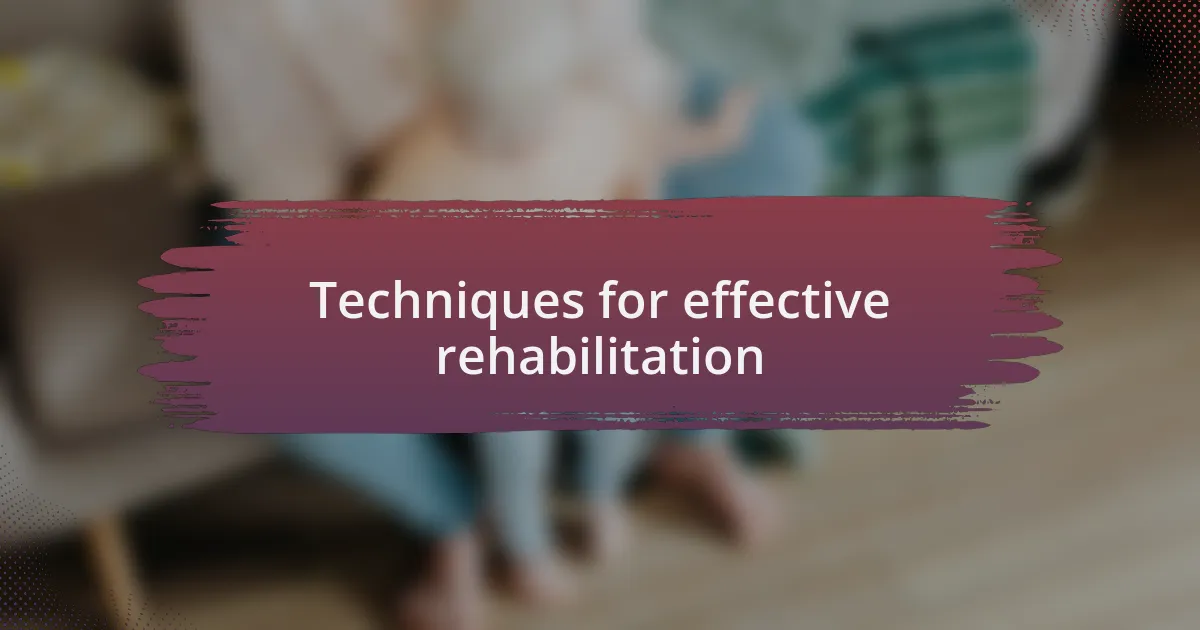
Techniques for effective rehabilitation
Finding the right techniques for rehabilitating abused cats is essential, and patience is key. I remember working with Luna, a cat who was terrified of anyone approaching her. Gradually, I learned that allowing her to dictate the pace of our interactions was crucial. By sitting quietly in her space, using soft voices, and letting her come to me, I was able to earn her trust. It’s amazing how much progress can be made when we simply listen to what they need.
Positive reinforcement is another powerful tool in rehabilitation. I recall training a shy cat named Oliver, who would only eat if I wasn’t watching. By placing treats in areas where he felt safest, I encouraged him to come out of his shell. Over time, he began to associate my presence with positive experiences. It made me wonder, how often do we overlook the simple power of rewards in fostering trust and security?
Environmental enrichment plays a vital role, too. When I set up a cozy corner for a particularly anxious rescue named Daisy, I filled it with toys and hiding spots. I saw her transform slowly as she explored her space at her own pace. It struck me that creating a safe and stimulating environment can significantly impact a cat’s healing process. How much more confident can they become with a little space to be themselves?
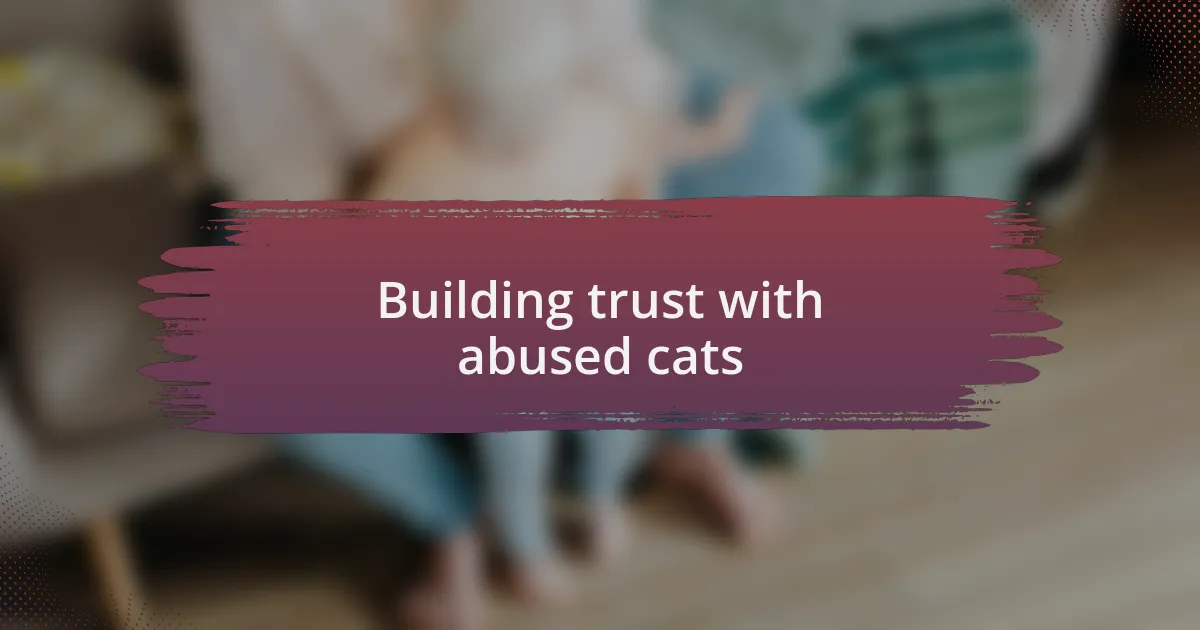
Building trust with abused cats
Building trust with an abused cat is a delicate process, and I’ve always found that it starts with understanding their body language. I remember a cat named Bella, who would flatten her ears and hiss at the slightest movement. By taking a step back and observing her reactions, I realized that even small gestures, like avoiding eye contact initially, made a difference. Isn’t it fascinating how much our nonverbal cues can either soothe or scare an animal?
One technique that has worked wonders for me is creating routines. When I fostered a timid tabby named Max, I established consistent feeding times and play sessions. It didn’t take long for him to realize that I was a reliable source of food and fun. Over time, he began to seek me out for those moments. Isn’t it remarkable how predictability can cultivate trust?
I can’t stress enough how critical it is to respect a cat’s boundaries. There was a time when I tried to pick up a cat named Felix, who had clearly had enough of my company. He scratched me in protest, which taught me to approach every interaction with caution and respect. Allowing them to come to you when they’re ready fosters a deeper connection. How empowering is it to witness a cat take that leap of faith?
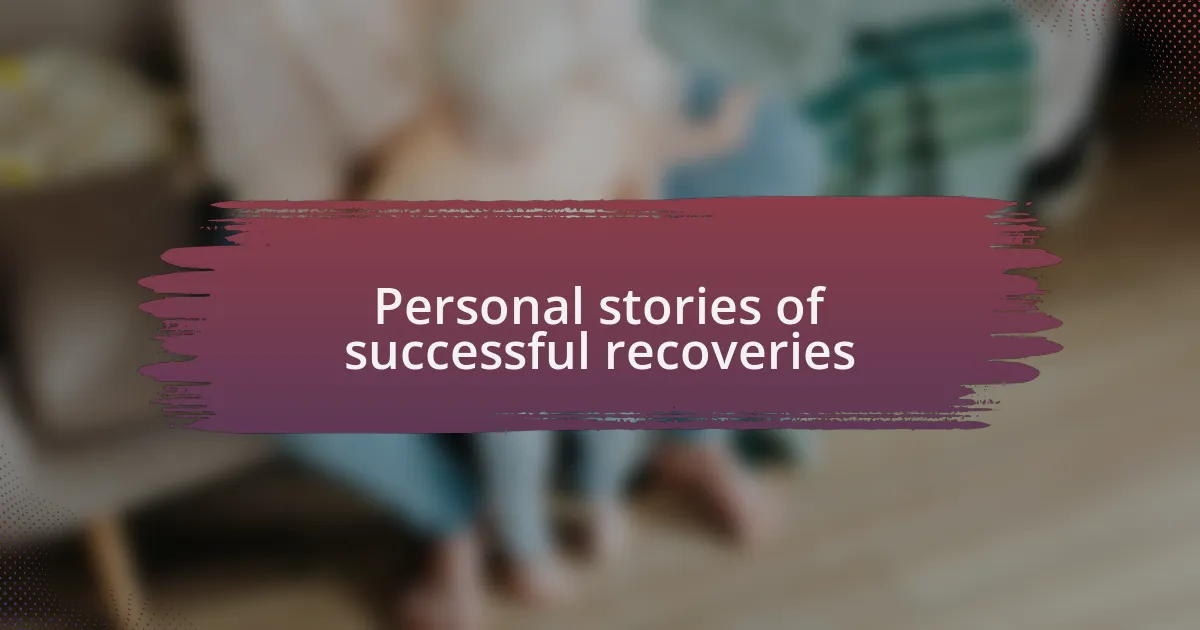
Personal stories of successful recoveries
It’s truly inspiring to see how far a cat can come with patience and love. I remember a little calico named Luna, who spent her first few weeks hiding under the couch. One day, as I sat quietly on the floor, she decided to peek out, slowly inching closer. That moment, with her cautious curiosity, was a beautiful reminder of how small steps can lead to monumental progress.
I once worked with a sweet Siamese named Oscar who had suffered severe neglect. During our sessions, he would often freeze at sudden noises. As I gently introduced him to new sounds—like the rustling of paper or the playful jingle of a toy—he began to associate these triggers with positive experiences. Isn’t it amazing how linking fear to joy can transform a cat’s life?
One of the most memorable success stories was of a ginger tabby named Simba. After months of gentle encouragement, he finally climbed onto my lap during a quiet evening. The warmth of his purring against my leg felt like a personal victory, a testament to the bond we had nurtured. Each time I reflect on that moment, I can’t help but think: what does it take for our furry friends to trust us, and how rewarding is it when they finally do?